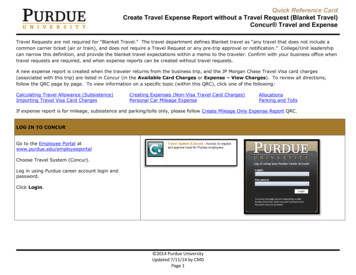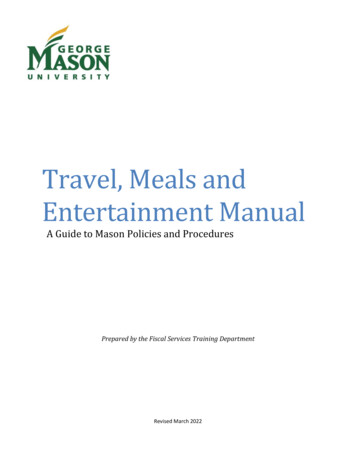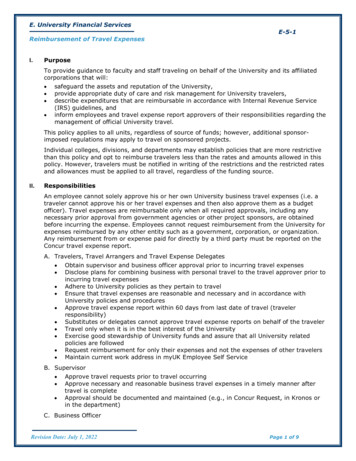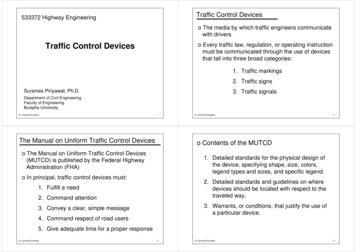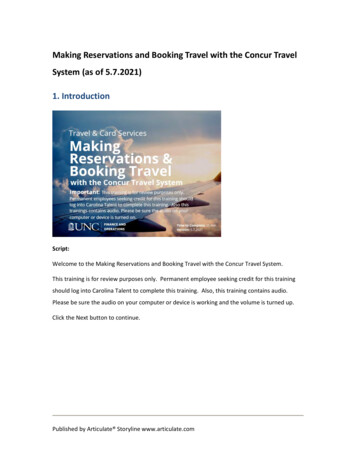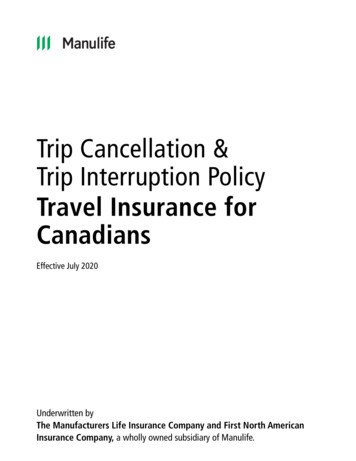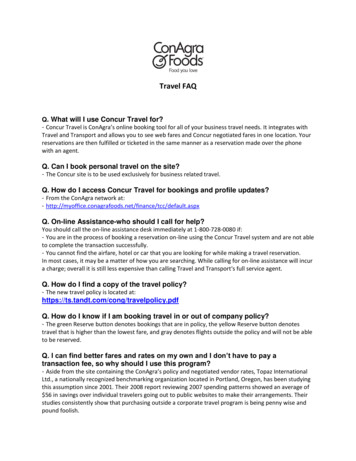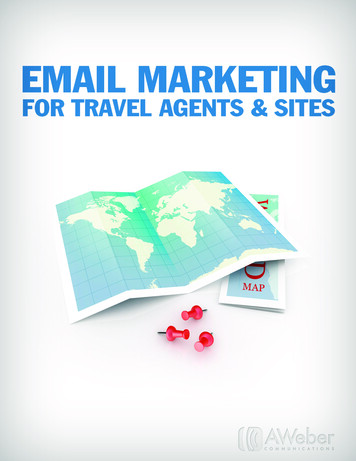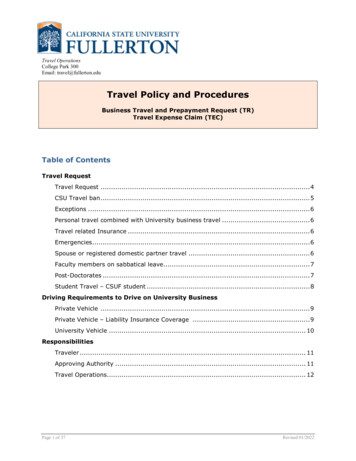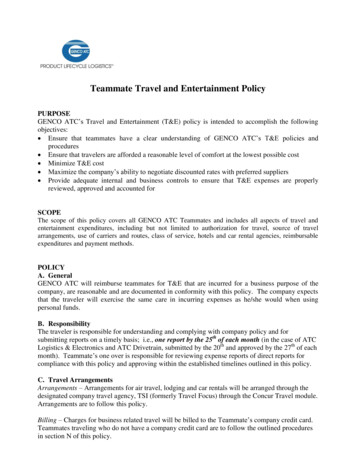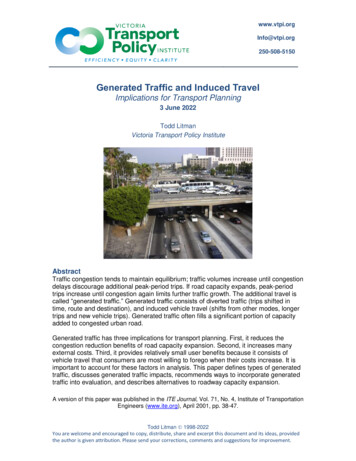
Transcription
www.vtpi.orgInfo@vtpi.org250-508-5150Generated Traffic and Induced TravelImplications for Transport Planning3 June 2022Todd LitmanVictoria Transport Policy InstituteAbstractTraffic congestion tends to maintain equilibrium; traffic volumes increase until congestiondelays discourage additional peak-period trips. If road capacity expands, peak-periodtrips increase until congestion again limits further traffic growth. The additional travel iscalled “generated traffic.” Generated traffic consists of diverted traffic (trips shifted intime, route and destination), and induced vehicle travel (shifts from other modes, longertrips and new vehicle trips). Generated traffic often fills a significant portion of capacityadded to congested urban road.Generated traffic has three implications for transport planning. First, it reduces thecongestion reduction benefits of road capacity expansion. Second, it increases manyexternal costs. Third, it provides relatively small user benefits because it consists ofvehicle travel that consumers are most willing to forego when their costs increase. It isimportant to account for these factors in analysis. This paper defines types of generatedtraffic, discusses generated traffic impacts, recommends ways to incorporate generatedtraffic into evaluation, and describes alternatives to roadway capacity expansion.A version of this paper was published in the ITE Journal, Vol. 71, No. 4, Institute of TransportationEngineers (www.ite.org), April 2001, pp. 38-47.Todd Litman 1998-2022You are welcome and encouraged to copy, distribute, share and excerpt this document and its ideas, providedthe author is given attribution. Please send your corrections, comments and suggestions for improvement.
Generated Traffic: Implications for Transport PlanningVictoria Transport Policy InstituteIntroduction . 2Defining Generated Traffic . 3Measuring Generated Traffic . 6Modeling Generated Traffic . 11Land Use Impacts . 13Costs of Induced Travel . 14Calculating Consumer Benefits. 17Emission Impacts . 19Example . 20Counter Arguments . 24Alternative Transport Improvement Strategies . 26Legal Issues . 27Conclusions. 28References and Information Resources . 291
Generated Traffic: Implications for Transport PlanningVictoria Transport Policy InstituteIntroductionTraffic engineers often compare traffic to an uncompressible fluid, assuming that a certainvolume must flow through the road system, but it is more appropriate to compare urban trafficto a gas that expands to fill available space (Jacobsen 1997). Traffic congestion tends to maintainequilibrium: traffic volumes increase to the point that congestion delays discourage additionalpeak-period vehicle trips. Expanding congested roads attracts latent demand, trips from otherroutes, times and modes, and encourages longer and more frequent travel. This is calledgenerated traffic, referring to additional peak-period vehicle traffic on a particular road. Thisconsists in part of induced travel, which refers to absolute increases in vehicle miles travel (VMT)compared with what would otherwise occur (Hills 1996; Schneider 2018).Generated traffic reflects the economic “law of demand,” which states that a good’sconsumption generally increases as its price declines. Roadway improvements that reduce theuser costs of driving (i.e., the price) encourage more vehicle travel. In the short-run generatedtraffic represents a shift along the demand curve; reduced congestion reduces travel time andvehicle operating costs (Lee, Klein and Camus 1999). Over the long run it represents an outwardshift in the demand curve as transport systems and land use patterns become more automobiledependent, so people must drive more to maintain a given level of accessibility to goods,services and activities (Deakin, et al. 2020).This is not to ignore roadway expansion benefits, but generated traffic affects their nature.Accurate transport planning and project appraisal considers these three effects:1. Generated traffic reduces the predicted congestion reduction benefits of road capacity expansion (atype of rebound effect).2. Induced travel increases many costs, including user expenses, downstream congestion, crashes,parking costs, pollution, and other environmental impacts. Many of these costs are external andtherefore inefficient and unfair.3. The additional vehicle traffic provide relatively modest user benefits since it consists of marginalvalue vehicle-miles that consumers are most willing to forego if their costs slightly increase.Ignoring these factors distorts planning decisions. Experts conclude, “ the economic value of ascheme can be overestimated by the omission of even a small amount of induced traffic. Weconsider this matter of profound importance to the value-for-money assessment of the roadprogramme” (SACTRA 1994). “ quite small absolute changes in traffic volumes have asignificant impact on the benefit measures. Of course, the proportional effect on scheme NetPresent Value will be greater still” (Mackie, 1996) and “The induced travel effects of changes inland use and trip distribution may be critical to accurate evaluation of transit and highwayalternatives” (Johnston, et al. 2001)This paper describes how generated traffic can be incorporated into transport planning. Itdefines different types of generated traffic, discusses their impacts, and describes ways toincorporate generated traffic into transport modeling and planning, and provides informationon strategies for using existing roadway capacity more efficiently.2
Generated Traffic: Implications for Transport PlanningVictoria Transport Policy InstituteDefining Generated TrafficGenerated traffic is the additional peak-period vehicle traffic that results from a roadimprovement, particularly urban roadway expansions. Congested roads cause people to deferless-urgent trips, change modes and destinations, and forego avoidable trips. Generated trafficconsists of diverted travel (shifts in time and route) and induced travel (increased total motorvehicle travel). Highway expansion can stimulate sprawl (dispersed, automobile-dependentdevelopment) which further increasing per capita vehicle travel.Below are examples of decisions that generate traffic: Consumers choose closer destinations when roads are congested and further destinationswhen traffic flows more freely. “I want to try the new downtown restaurant but traffic is amess now. Let’s just pick up something at the local deli.” This also affects long-termdecisions. “We’re looking for a house within 40-minute commute time of downtown. Withthe new highway open, we’ll considering anything as far as Midvalley.” Travelers shift modes to avoid driving in congestion. “The post office is only five blocks awayand with congestion so bad this time of day, I may as well walk there.” Longer trips may seem cost effective when congestion is light but not when congestion isheavy. “We’d save 5 on that purchase at the Wal-Mart across town, but it’s not worthfighting traffic so let’s shop nearby.”Travel time budget research indicates that increased travel speeds often results in more mobilityrather than saving time (Marchetti 1994). People tend to average about 75 minutes of dailytravel time regardless of transport conditions (Ahmed and Stopher 2014). National data indicatethat as freeway travel increases, average commute trip distances and speeds increase, but triptime stays about constant (Levinson and Kumar 1997). As a result, traffic congestion tends tomaintain a self-limiting equilibrium: it increases until delays discourage further peak-periodvehicle trips. Road expansions that reduce congestion attract more peak-period trips untilcongestion once again reaches a level that limits further growth (Krol 2020). It may therefore beincorrect to claim that congestion reductions save travel time over the long run.DefinitionsGenerated Traffic: Additional peak-period vehicle trips on a particular roadway that occur when capacity isincreased. This may consist of shifts in travel time, route, mode, destination and frequency.Induced travel: An increase in total vehicle mileage due to roadway improvements that increase vehicle tripfrequency and distance, but exclude travel shifted from other times and routes.Latent demand: Additional trips that would be made if travel conditions improved (less congested, higherdesign speeds, lower vehicle costs or tolls).Triple Convergence: Increased peak-period vehicle traffic volumes that result when roadway capacityincreases, due to shifts from other routes, times and modes.3
Generated Traffic: Implications for Transport PlanningVictoria Transport Policy InstituteFigure 1 illustrates this pattern. Traffic volumes grow until congestion develops, then the growthrate declines and achieves equilibrium, indicated by the curve becoming horizontal. A demandprojection made during this growth period will indicate that more capacity is needed, ignoringthe tendency of traffic volumes to eventually level off. If additional lanes are added there will beanother period of traffic growth as predicted.Figure 1How Road Capacity Expansion Generates TrafficTraffic Volume With Added CapacityTraffic Lanes and VolumeTraffic Volume Without Added ime ---- Traffic grows when roads areuncongested, but the growthrate declines as congestiondevelops, reaching a self-limitingequilibrium (indicated by thecurve becoming horizontal). Ifcapacity increases, traffic growsuntil it reaches a newequilibrium. This additionalpeak-period vehicle travel iscalled “generated traffic.” Theportion that consists of absoluteincreases in vehicle travel (asopposed to shifts in time androute) is called “induced travel.”RoadwayCapacityAddedGenerated traffic can be considered from two perspectives. Highway planners are primarilyconcerned with the traffic generated on the expanded road segment, since this affects theproject’s congestion reduction benefits. A broader perspective is concerned with changes intotal vehicle travel (induced travel) that affect overall benefits and costs. Table 1 describesvarious types of generated traffic. In the short term, most generated traffic consists of tripsdiverted from other routes, times and modes, called Triple Convergence (Downs 1992). Over thelong term an increasing portion is induced travel. In some situations, adding roadway capacitycan reduce overall network efficiency, called Braess’s Paradox (Youn, Jeong and Gastner 2008).Highway capacity expansion can induce additional vehicle travel on adjacent roads bystimulating more dispersed, automobile-dependent development (Hansen, et al. 1993).Although these indirect impacts are difficult to quantify they are potentially large and should beconsidered in transport policy and planning analysis (Byun, Park and Jang 2017).4
Generated Traffic: Implications for Transport PlanningVictoria Transport Policy InstituteTable 1Types of Generated TrafficType of Generated TrafficShorter Route – Improved road allows drivers to usemore direct route.Longer Route – Improved road attracts traffic frommore direct routes.Time Change – Reduced peak period congestionreduces the need to defer trips to off-peak periods.Mode Shift; Existing Travel Choices – Improved trafficflow makes driving relatively more attractive than othermodes.Mode Shift; Changes in Travel Choice – Less demandleads to reduced rail and bus service, less suitableconditions for walking and cycling, and more automobileownership.Destination Change; Existing Land Use – Reduced travelcosts allow drivers to choose farther destinations. Nochange in land use patterns.Destination Change; Land Use Changes – Improvedaccess allows land use changes, especially urban fringedevelopment.New Trip; No Land Use Changes – Improved travel timeallows driving to substitute for non-travel activities.Automobile Dependency – Synergetic effects ofincreased automobile oriented land use andtransportation system.Diverted tripTravelImpactsSmallShort term reductionDiverted tripShort term Small increase Slight increaseDiverted trip.Short term NoneSlight increaseInducedvehicle tripIncreasedShort term drivingModerate tolarge lternativesInducedvehicle tripLong termLonger tripShort term IncreaseMore drivingand autodependencyLonger tripLong termInduced tripShort term IncreaseIncreaseddriving, fewerLong term alternativesInduced tripCostImpactsReductionLarge increase,reduced equityModerate tolarge increaseModerate tolarge increase,equity costsLarge increaseLarge increase,reduced equitySome types of generated traffic represent diverted trips (trips shifted from other times or routes)while others increase total vehicle travel, reduce travel choices, and affect land use patterns.What constitutes short- and long-term impacts can vary. Some short term effects, such as modeshifts, may accumulate over several years, and some long term effects, such as changes indevelopment patterns, can begin almost immediately after a project is announced if marketconditions are suitable. Roadway expansion impacts tend to include: First order. Reduced congestion delay, increased traffic speeds. Second order. Changes in time, route, destination and mode. Third order. Land use changes. More dispersed, automobile-oriented development. Fourth order. Overall increase in automobile dependency. Degraded walking and cyclingconditions (due to wider roads and increased traffic volumes), reduced public transit service(due to reduced demand and associated scale economies, sometimes called the Downs-Thomsonparadox), and social stigma associated with alternative modes (Noland and Hanson 2013, p. 75).Such impacts can also occur in reverse: reducing urban roadway capacity often reduces totalvehicle travel (Cairns, Hass-Klau and Goodwin 1998; CNU 2011; ITDP 2012; ITF 2021) which issometimes called traffic evaporation (EC 2004).5
Generated Traffic: Implications for Transport PlanningVictoria Transport Policy InstituteMeasuring Generated TrafficNumerous studies using various analysis methods have quantified generated traffic and inducedtravel impacts (Deakin, et al. 2020; WSP 2018). Their findings are summarized below: The National Center for Sustainable Transportation’s Induced Travel Calculator (NCST 2019)estimates the incremental vehicle travel induced by adding general-purpose or high-occupancyvehicle (HOV) lane miles to roadways. It is calibrated for California’s urbanized counties, but themethodology is transferable to other geographic areas. Sophisticated analyses of 545 European cities indicates that urban highway expansion tends toincrease vehicle traffic and so fails to solve congestion (Garcia-López, Pasidis, and ViladecansMarsal 2020). The study indicates that each 1% increase in highway lane-kilometers typicallyincreases total vehicle kilometers by 1.2%. The analysis found significantly less congestion(indicated by vehicle-kms relative to the log of lane-kms) in cities with road pricing and highquality rail transit. A 1% increase in lane kilometers increases congestion by 1.9% in citieswithout highway tolls but only 0.3% in cities with tolls. A 1% increase in railroad network lengthdecreases congestion by 0.6% in a city without subways, 0.8% in a city with the average share ofsubways, and 1.3% in a city where the majority of the railroad network consists of subways. The report, The Congestion Con: How More Lanes and More Money Equals More Traffic (TfA2020) analyzed how roadway expansions affected per capita congestion delay in the 100 largesturbanized areas in the U.S. between 1993 and 2017. During that period governments spentmore than 500 billion on highway projects but congestion grew 144%, far more thanpopulation, and the regions that expanded roads the most tended to have more congestiongrowth than those that expanded less. The authors concluded that this resulted from generatedtraffic which filled the added capacity. plus the long-term effects of increased sprawl andincreased per capita vehicle travel induced by the additional roadway capacity. Detailed analysis by Hymel (2019) found that U.S. vehicle miles traveled increase in proportionwith lane-mileage, and capacity expansion congestion relief generally vanishes within five years. A Statistical Model of Regional Traffic Congestion in the United States (Marshall 2016) used realtime traffic data to analyze factors that affected congestion in 74 U.S. urban regions. It foundthat more arterial capacity is related to less congestion but more freeway capacity is not. Itfound that congestion increases with incomes indicating that economic productivity attractspopulation growth, which also increases congestion. The study concludes that in congestedurban areas, arterial expansion may reduce congestion but freeway expansions do not. Graham, McCoy and Stephens (2014) quantify roadway capacity expansion effects on aggregateurban traffic volume and density in U.S. cities using a mixed model propensity score estimatorwhich accounts for confounding unobserved characteristics. They found that a 10% increase inlane miles increases average VMT 9% beyond ‘natural growth.’ They conclude that even majorurban highway expansions can provide little or no long-term congestion reductions. A review by Handy and Boarnet (2014) found that short-run highway expansion elasticitiesgenerally range from 0.3 to 0.6, and long-run effects typically range from 0.6 to just over 1.0,meaning that each 10% increase in road capacity increases traffic volumes by 3-6% within twoyears, and 6-10% after about five years. They found that more recent studies using moresophisticated methodologies tend to find higher elasticities. They conclude that expandingcongested urban highways is unlikely to reduce long run congestion or associated GHGs.6
Generated Traffic: Implications for Transport PlanningVictoria Transport Policy Institute Duranton and Turner (2008) found that in U.S. urban regions, vehicle travel increasesproportionately to highway capacity due to four effects: increased driving by current residents,an inflow of new residents, and more transport intensive production activity. They concludethat, without congestion pricing, increasing road or public transit supply is unlikely to relievecongestion, and current roadway supply exceeds optimums. Cervero (2003a & 2003b) used data on freeway capacity, traffic volumes, demographic andgeographic factors in California between 1980 and 1994. He estimated a 0.64 long-term elasticityof VMT with respect to traffic speed, meaning that a 10% speed increases VMT 6.4%, about aquarter of which results from land use changes (e.g., additional urban fringe development). Heestimated that about 80% of additional roadway capacity is filled with additional peak-periodtravel, about half of which (39%) can be considered the direct result of the added capacity. Noland (2001) and (Noland and Lem 2002) used time-series travel data for various roadwaytypes to evaluate induced travel. They found an elasticity of vehicle travel with respect to lanemiles of 0.5 in the short run, and 0.8 in the long run. This means that half of increased roadwaycapacity is filled with added travel within about 5 years, and that 80% of the increased roadwaycapacity will be filled eventually. Leading U.K. transportation economists concludes that the elasticity of travel volume withrespect to travel time is -0.5 in the short term and -1.0 over the long term (SACTRA 1994). Thismeans that reducing travel time on a roadway by 20% typically increases traffic volumes by 10%in the short term and 20% over the long term. The following are elasticity values for vehicletravel with respect to travel time: urban roads, short-term -0.27, long term –0.57; rural roads,short term –0.67, long term –1.33 (Goodwin 1996). Noland and Quddus (2006) found that increases in road space or traffic signal control systems thatsmooth traffic flow tend to induce additional vehicle traffic which quickly diminish any initialemission reduction benefits. Tennøy, Tønnesen and Gundersen (2019) found that Norwegian highway expansions provideonly short-term congestion relief, and by increasing sprawled development, increase total trafficgrowth. They find that road authorities generally overlooked these effects. Cervero and Hanson (2000) found the elasticity of VMT with respect to lane-miles to be 0.56,and an elasticity of lane-miles with respect to VMT of 0.33, indicating that roadway capacityexpansion results in part from anticipated traffic growth. A comprehensive study found that in the U.S., a 10% increase in urban road density (lane-milesper square mile) increases per capita annual VMT by 0.7% (Barr 2000). Yao and Morikawa (2005) analyzed the travel induced by high speed rail improvements betweenmajor Japanese cities. They calculate elasticities of induced travel (trips and VMT) with respectto fares, travel time, access time and service frequency for business and nonbusiness travel. Odgers (2009) found that Melbourne, Australia freeway traffic speeds did not increase aspredicted following highway construction, apparently due to induced traffic. He concludes that,“major road infrastructure initiatives and the consequent economic investments have not yetdelivered a net economic benefit to either Melbourne’s motorists or the Victorian community.”7
Generated Traffic: Implications for Transport PlanningVictoria Transport Policy Institute Burt and Hoover (2006) found that each 1% increase in road lane-kilometres per driving-ageperson increases per capita light truck travel 0.49% and car travel 0.27%, although they reportthat these relationships are not statistically significant, falling just outside the 80% confidenceinterval for cars and the 90% confidence interval for light trucks. Hymel, Small and Van Dender (2010) used 1966-2004 U.S. state-level cross-sectional time seriesdata to evaluate how income, fuel price, road supply and traffic congestion affect vehicle milestravel (VMT). They find the elasticity of VMT with respect to statewide road density is 0.019 inthe short run and 0.093 in the long run (a 10% increase in total lane-miles per square mileincreases state vehicle mileage by 0.19% in the short run and 0.93% in the long run); withrespect to total road miles is 0.037 in the short run and 0.186 in the long run (a 10% increase inlane-miles causes state VMT to increase 0.37% in the short run and 1.86% over the long run);and vehicle use with respect to congestion is -0.045 (a 10% increase in total regional congestionreduces regional VMT 0.45% over the long run), but this increases with income, assumedlybecause the opportunity cost of time increases with wealth. Their analysis indicates that longrun travel elasticities are typically 3.4–9.4 times short-run elasticities. The Handbook of Transportation Engineering finds that urban highway capacity expansion oftenfails to significantly increase travel speeds due to latent demand (Kockelman 2010). They concludethat the long-run elasticities of VMT with respect to roadspace is generally 0.5 to 1.0 aftercontrolling for population growth and income, with values of almost 1.0, suggesting that newroadspace is totally filled by generated traffic where congestion is relatively severe. A meta-analysis by Schiffer, Steinvorth and Milam (2005) reached the following conclusions:oInduced travel effects exist – The elasticity of VMT with respect to added lane-miles orreductions in travel time is generally greater than zero and the effects increase over time.Figure 3 summarizes their results.oShort-term induced travel effects are smaller than long-term effects – As measured by theincrease in VMT with respect to an increase in lane-miles, short-term effects have anelasticity range from near zero to about 0.40, while long-term elasticities range from about0.50 to 1.00. This means that a 10% increase in lane-miles can cause up to a 4% increase inVMT in the short term and a 10% increase in the long term.oInduced travel effects generally decrease with the size of the unit of study – Larger effects aremeasured for single facilities while smaller effects are measured for regions and subareas.This is mainly due to diverted trips (drivers changing routes) causing more of the change on asingle facility, whereas, at the regional level, diverted trips between routes within the regionare not considered induced travel unless the trips become longer as a result.oTraditional four-step travel demand models do not fully address induced travel or inducedgrowth – Land use allocation methods overlook accessibility effects, trip generation oftenfails to account for latent trips (potential trips constrained by congestion), many modelsoverlook time-of-day shifts, and static traffic assignment algorithms may not account forqueuing impacts on route shifts; all of which underestimate generated traffic effects.8
Generated Traffic: Implications for Transport PlanningVictoria Transport Policy InstituteFigure 3VMT With Respect to Road Capacity (Schiffer, Steinvorth and Milam 2005)This figuresummarizes long termvehicle travelelasticities withrespect to roadwaycapacity. Melo, Graham and Canavan (2012) found a positive relationship between urban highwayexpansion and vehicle travel in the U.S. between 1982 and 2009. Rahmana, Bakerb and Rahmanc (2020) found that in Dhaka, Bangladesh, urban intersectionflyovers typically provide a one-minute time savings, which increased affected vehicle tripgeneration by 35%. Özuysal and Tanyel (2008) found the elasticity of travel per vehicle relative to Turkish statehighway supply is 2.0 for private vehicles and 3.5 for commercial vehicles over 3-5 year periods. Analysis by Professor Ismail Sahin of Turkey’s Yildiz Technical University shows that after newbridges were built in Istanbul, traffic volumes increased, representing induced vehicle trips,resulting in a new, higher level of congestion equilibrium.Figure 4Istanbul Bridge Traffic Volumes (Personal correspondence withProfessor Ismail Sahin 2015)This graph shows AverageAnnual Daily Trips (AADTs)on Bosporus Bridge (bluebars) opened in 1973 andFatih Sultan Mehmet (FSM)Bridge (orange bars) openedin 1988. This shows thetendency of traffic volumesto fill the new capacity andthen reach equilibrium ascongestion becomes selflimiting.9
Generated Traffic: Implications for Transport PlanningVictoria Transport Policy InstituteThe amount of traffic generated by a road project varies depending on conditions. It is notcapacity expansion itself that generates travel, it is the reduction in delay and therefore per-miletravel costs (Milam, et al. 2017). Expanding uncongested roads generates no traffic, althoughpaving a dirt road or significantly raising roadway design speeds may induce more vehicle travel.In general, the more congested a road, the more traffic is generated by expansions. Increasedcapacity on highly congested roads often generates considerable traffic. Older studies of theelasticity of VMT growth with respect to increased roadway lane-miles performed during theearly years of highway building (during the 1950s through 1970s) have little relevance forevaluating current urban highway capacity expansion. In developed countries, where mosthighway expansion now occurs on congested links, such projects are likely to generateconsiderable amounts of traffic, providing only temporary congestion reduction benefits.Gridlock?People sometimes warn of roadway gridlock without some recommended action, such as roadway expansion. Suchclaims are usually exaggerated because they ignore traffic congestion’s tendency toward equilibrium. Gridlock is aspecific condition that occurs when backups in a street network block intersections, stopping traffic flow. Gridlockcan be avoided with proper intersection design and traffic law enforcement. Increasing regional highway capacitycan increase this risk by adding more traffic to surface streets where gridlock occurs.Generated traffic usually accumulates over several years. Under typical urban conditions, morethan half of added capacity is filled within five years of project completion by additional vehicletrips that would not otherwise occur, with continued but slower growth in later years (Goodwin1998). Figure 5 shows typical generated traffic growth based on various studies. Techniques formode
leads to reduced rail and bus service, less suitable conditions for walking and cycling, and more automobile ownership. alternatives Induced vehicle trip Long term Increased driving, reduced Large increase, reduced equity Destination Change; Existing Land Use - Reduced travel costs allow drivers to choose farther destinations. No
